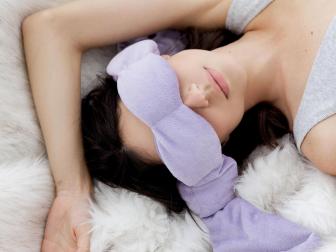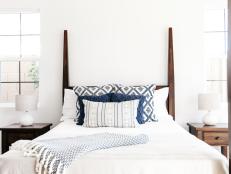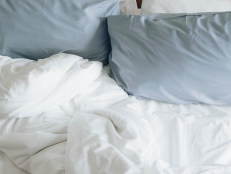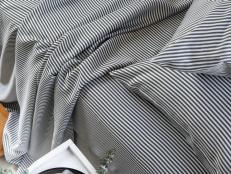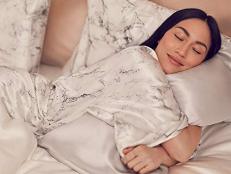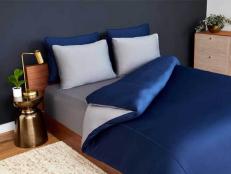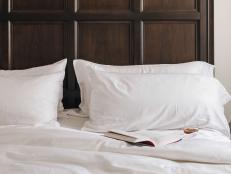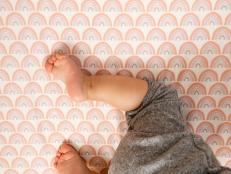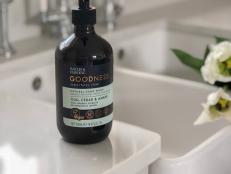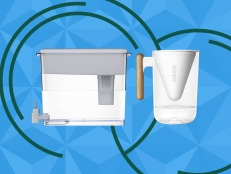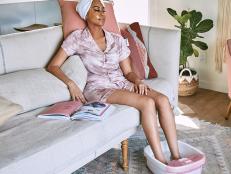I Tried the Oura Ring for Four Weeks — Here's How It Changed My Sleep
We took a deep dive into the Oura Ring sleep tracker to review how well it can actually improve sleep habits and lead to a better night of rest.


Oura
You could have the most comfortable mattress and the plushiest pillows yet still sleep terribly. Fostering healthy sleep habits is key to avoiding sleep deficiency. Unfortunately, it’s easy to push those healthy habits aside, which is why many busy people rely on commercial wearables like smart watches and rings to help them stay on track — even if studies show that they’re not always perfect.
Despite being a sleep writer and mattress tester, I know that my sleep hygiene could be better. Most glaringly, I spend too much time on my phone before bed, so it may seem ironic that I’d rely on a device like the Oura Ring to help me curb my midnight scrolling. But if it’s helped Mark Zuckerberg and Kim Kardashian make time for quality snoozing in their extraordinarily busy lives, then I figured it must be worth a try.
Developed by ŌURA (said like “aura”), the Oura Ring is a smart wearable that “offers a remarkable amount of sleep data with an unmatched degree of accuracy,” says ŌURA Vice President of Consumer Software, Product, Jason Russell. “[Wearers] can gain insight into their time spent in different sleep stages, how restful their sleep was, how their resting heart rate changed throughout the night, how easily they fell asleep, and much more.”
For one month, I used an Oura Ring to track my sleep. While I wasn’t expecting a dramatic shift in my sleep (nor should that be the expectation in such a relatively small window), I did learn a lot about how quality sleep is connected to my habits throughout the day, not just an hour or two before bedtime. Here’s my honest review after spending four weeks wearing an Oura Ring.
What is the Oura Ring?
Finnish health tech company ŌURA introduced its sleep-tracking wearable, the Oura Ring, in 2015 after a successful Kickstarter campaign. In 2021, ŌURA released its third (and current) iteration, the Oura Ring Gen3, which we’re reviewing here. It boasts a much sleeker design, more accurate data tracking, and a broader range of features.
The Oura Ring houses multiple sensors that track sleep, activity, heart rate, skin temperature, and blood oxygen (SpO2), You’ll be able to track those metrics via the Oura App for iPhone or Android. If you use another health tracker, you can sync your Oura Ring data to third-party apps like Health Connect, Google Fit, Natural Cycles, and Strava.
- Stylish and comfortable for daily wear
- Oura App is user friendly
- Ring holds a charge for up to a
- Can opt out of notifications and calorie counting
- Eligible for purchase with FSA/HSA
- Activity tracking is inconsistent
- Find My Ring feature missing on Android app
- Could benefit from a natural alarm clock
- Requires GPS for most accurate results
- Pricey and requires a monthly membership
Like other wearables, the Oura Ring uses gamification to gauge performance and serve as motivation. ŌURA’s three pillars of scoring are Sleep, Activity, and Readiness. The first two categories are self-explanatory, but Readiness encompasses every biometric signal the Oura Ring picks up to provide a holistic view of your well-being on any given day. According to ŌURA, Readiness means, “How much can you and your body take on?”
ŌURA Vice President of Consumer Software, Product Jason Russell explains that the Oura Ring helps make sense of our complex bodies by offering “a wide range of health data around Sleep, Activity, Readiness, women’s health, stress, and more, while connecting the dots for members in a non-intrusive way that makes it easy to interpret and act on the most meaningful patterns in their data.” (Users can opt-out of notifications and calorie counting.)
The Oura Ring Gen3 is made from titanium with a scratch-resistant, diamond-like coating. It comes in two styles. The Heritage (from $299) has a flat-top design and comes in four finishes, while the Horizon (from $349) has a smooth, rounded appearance and comes in six finishes. An Oura Membership is required for full access to features and costs $5.99 per month, although the first month is free.
You can buy the Oura Ring at Best Buy, Amazon, or directly from ŌURA. It’s eligible for purchase with a Health Savings Account (HSA) or a Flexible Spending Account (FSA). However, HSA/FSA funds aren’t applicable toward the monthly Oura Membership.
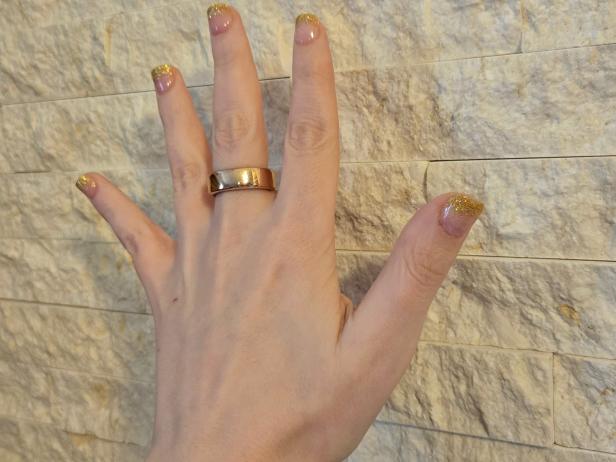
Alison Barretta
How I Tested the Oura Ring
For one month, I wore an Oura Ring Gen3 (Horizon style, Rose Gold finish) on the middle finger of my non-dominant (left) hand, removing it only to wash my hands, shower, or charge it.
Note that ŌURA suggests wearing the ring on your index finger for the most accurate readings; however, I was most comfortable wearing it on my middle finger. According to ŌURA the middle or ring fingers are suitable alternatives, provided the ring has a secure fit. Plus, I didn’t notice a marked difference in stats when I temporarily moved the Oura Ring to my index finger.
How to Set Up the Oura Ring
The setup process for my Oura Ring began before I even received it. ŌURA sent me a sizing kit with a collection of plastic rings fashioned to look like the real deal, including nubs in place of the sensors. Oura Ring sizing isn’t 1:1 to traditional ring sizes – they run slightly smaller. (Case in point: I typically wear a size 7 ring but went with a size 10.) This sizing kit is an optional free add-on at checkout, but I strongly recommend it if you’ve never worn an Oura Ring.

Alison Barretta
I wore my sample size 10 Oura Ring for the recommended 24 hours to get a feel for what it’d be like to wear one while sleeping, typing, or engaging in other activities. (Plus, my fingers tend to swell when I work out or indulge in a little too much salt.) Once I was satisfied with the fit of my mock ring, I placed an order for the size, style, and finish I wanted. Several days later, I received my Oura Ring Gen3 and paired it to my Samsung Galaxy S10. The process took about 10 minutes from the moment I downloaded the free Oura App, with the Oura Ring sitting on its charging station. Once I created an Oura account, the app synced to the ring via my phone’s Bluetooth.

Alison Barretta
From there, I entered my details: date of birth, height, weight, assigned sex at birth, and preference for imperial or metric units. Following that were a set of questions to help the Oura Ring understand where I'm currently at regarding my sleep quality, energy levels, and daily stress. These answers help the device provide tailored, relevant suggestions. After a brief firmware update and tinkering with some other settings (notifications and third-party app sharing), my Oura Ring was ready for me to wear.
Overall, the setup was straightforward, although I recommend having a second device like a laptop or tablet to make things a little easier if you don’t already have an Oura account. You must also be comfortable with sharing your health data. (ŌURA does take measures to protect your privacy although it recommends keeping your phone’s GPS location on for best results.)
About a week later, I upgraded my phone to a Samsung Galaxy S24 and wanted to transfer my Oura Ring data to my new device. All I had to do here was place the ring on the charger, unpair my old phone, and download the Oura App to my new phone and follow the prompts.
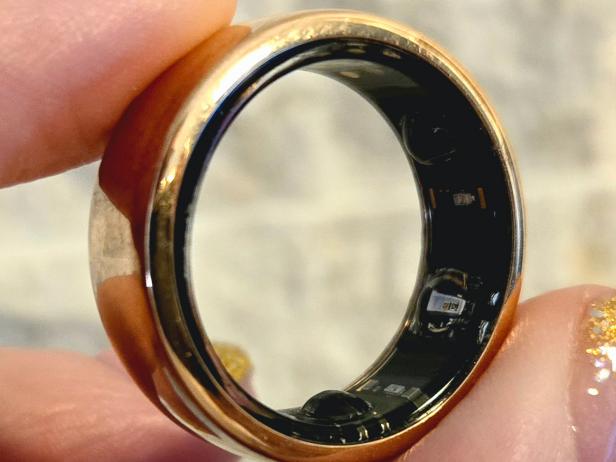
Alison Barretta
My First Week with the Oura Ring
Although I was satisfied with the size of my Oura Ring, it’s bulkier than the mockup used for sizing. I have slim fingers and don’t like to wear anything too clunky. (Eventually, I got used to wearing it and no longer needed to remove it while typing.)
That first week was purely for introduction – me to the Oura Ring, and the Oura Ring to my habits and baselines. Unfortunately, I was just getting over a cold, so the Oura Ring wasn’t meeting me at my very best. For the first couple of days, I put the Oura Ring into Rest Mode, which pauses activity tracking goals (either steps or calories burned) and shifts the focus to recovery.
Every day, the Oura App would introduce a new data point and provide details on how I can use that information to make better choices. (This lasted about two weeks.) It was too early for the ring to pick up on any trends, but it did put a harsh spotlight on my poor sleep hygiene: lingering in bed after waking up in the morning, using my phone right before going to bed, and not maintaining a consistent bedtime.
Case in point: My sleep quality trended upward for most of my first week, except for one morning when I spent a little too much time in bed after waking up. That was the deciding factor between a “good” Sleep score and the “fair” one I ultimately received that day. Now I knew where I needed to put in the work.
What HGTV Editors Are Buying for a Better Night's Sleep
Did the Oura Ring Help Improve My Sleep After One Month?
The Oura Ring didn’t have a dramatic impact on my sleep quality and daily habits after a month, but I did notice some small changes. Realistically, 30 nights isn’t a whole lot of time to dismantle years of poor sleep hygiene, though it’s a good start.
The Oura Ring made me aware of how little downtime I give myself. It monitors my daytime stress levels, which combines my heart rate, HRV, and skin temperature readings to gauge whether I’m in a state of stress or relaxation. Now stress isn’t always bad – it can even come from doing the things we love. However, not giving my mind time to unwind during the day is probably why falling asleep at night is difficult for me sometimes.
Throughout the month I committed myself to improving my sleep quality by developing healthy habits: breaking up my workday with some stretching or walking, ditching my smartphone for journaling at night, and maintaining a consistent bedtime. I haven't been perfect at incorporating these changes, but I’m cutting myself a break because good habits can be easy to form – and bad habits are often harder to break.
Fortunately, my efforts weren’t in vain, according to my Oura Ring. My sleep scores were often higher when I was able to wind down properly before bed and ignored hitting snooze in the morning. But alas, by the end of the month, I caught another cold. I was hard at work, meeting deadlines and tending to family matters. Despite sleeping well at night, I still wasn’t giving myself enough downtime during the day to recover from stress.
This ultimately affected my resilience, which the Oura Ring calculates by averaging my daytime stress loads and daytime and nighttime recovery levels. Unsurprisingly, my daytime recovery levels ranged from fair to “pay attention,” and not paying attention ultimately impacted my sleep quality and overall health.
As ŌURA Vice President of Consumer Software, Product Jason Russell told me, “Oura gives your body a voice, so you can hear and respond to its signals and know where to focus to improve your daily well-being and long-term health.” I consider my month with the Oura Ring a lesson in what happens when you knowingly ignore that voice.
What I Like About the Oura Ring
After a brief adjustment period, I think the Oura Ring is comfortable to wear, especially to bed. Plus, it looks stylish, so I don’t mind wearing it out during the day. It’s quite durable, too. I’ve been rough with my Oura Ring, wearing it during kickboxing class or when working with weights. (ŌURA doesn’t recommend doing this.) Aside from some very minor knicks, it looks fine and I’ve been able to use a soft cloth to wipe away smudges.
The Oura App is easy to navigate and does a good job of easing in new users by gradually introducing tidbits of information. I’ll admit that I felt a mild sense of data overload at first but now I seek out certain metrics to better understand why I feel energetic or groggy. I also like the collection of breathing and meditation exercises that are accessible through the Explore tab. I sometimes do these exercises on evenings when I’m too charged to fall asleep.
ŌURA claims a maximum battery life of seven days on a full charge. I found that accurate as I didn’t have to charge my Oura Ring too often, and whenever I had to, it took up to an hour and a half to reach 100% battery. However, one evening I fell asleep with my Oura Ring at 15% battery, and it didn’t track my sleep data. (ŌURA recommends keeping the battery level above 30% for sleep insights.) “Missing a few nights of sleep tracking won’t impact metrics,” Russell assures me, but consistency will yield the best results.
What the Oura Ring Could Do Better
I think the Oura Ring could benefit from a gentle smart alarm. I currently rely on my Amazon Echo to wake me up at a set time every morning, but I’m terrible about hitting snooze and I’m tired of (literally) yelling at my alarm clock. If the Oura Ring could vibrate when I’m approaching the end of my sleep cycle near my optimal wake time, I’m sure it would do wonders for my morning energy levels.
As a sleep tracker, I think the Oura Ring is excellent, but I’m not too fond of it as an activity tracker. Although I’ve worn my ring during some intense workouts, it doesn’t always detect when I’m exercising. I can add that information manually but then I’m left with estimates rather than exact data about my heart rate and number of calories burned during my sessions. (On the flip side, the ring doesn’t always detect when I’ve taken a nap, either.)
For the forgetful Android users among us, know that the Oura App doesn’t have the Find My Ring feature that’s present on the iPhone version. I misplaced my ring when I went out to lunch one afternoon. I was lucky and able to find it rather quickly – I left it in a restaurant bathroom after washing my hands – but being able to track it down through my phone would have kept my stress level at a minimum. (I learned after the fact that Android users must download a third-party device finder.)
Will I Keep Wearing My Oura Ring?
Yes, I plan to keep wearing my Oura Ring to track my sleep and overall wellness. I’ve begun to look forward to learning my Sleep and Readiness scores for the day. Maybe this is a mild placebo effect but knowing that my body is primed to take a day after a good night’s sleep motivates me to tackle whatever is ahead of me.
A month of wear is just scratching the surface, though. The longer I wear my ring, the more information it’ll be able to provide me with. For instance, I can learn my chronotype (whether I’m an early bird or a night owl) after 90 nights of wearing my Oura Ring. There’s still so much for it to tell me about my sleeping habits – and thus, more room for me to improve on them.
The Best Sleep Masks of 2024, Tested and Reviewed
The Bottom Line: The Oura Ring is Pricey, but Can Help Encourage Healthy Habits
If you’re exclusively interested in tracking your sleep, I think the Oura Ring could be a wise investment. It’s comfortable to wear and will open your eyes to the little things you do every day that impact your rest and recovery. Of course, you shouldn’t expect the Oura Ring to instantly transform your sleep. It’ll take months of consistent wear – and even then, it’ll be up to you to heed the calls of your body. Yes, it’s not cheap and you have to shell out for a monthly subscription, but if you have FSA or HSA funds to spare, you can put those tax-free dollars towards a new Oura Ring. Even if you don’t, I believe the Oura Ring is still worth the cost.







